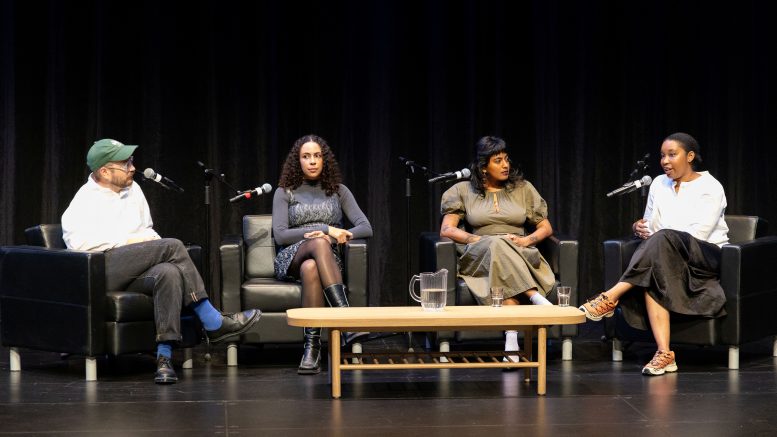The U of M’s School of Art Gallery invited two emerging curators in 2021, Lillian O’Brien Davis and Shalaka Jadhav, to create exhibitions and receive mentorship from Grace Deveney, an associate curator of photography and media at the Art Institute of Chicago. Previously, Deveney was an associate curator of the art triennial Prospect in New Orleans.
The program resulted in three art shows — Open Structure by Deveney, The Performance of Shadows by Davis and To Broadcast is to Scatter by Jadhav.
On Oct. 16, the three curators gathered in Desautels Concert Hall to speak about their experiences in the now-completed program in an event titled Exchange as a Symmetrical Gesture. The night began with artist Erika DeFreitas reciting poetry to accompany her compositions, the on a colourless blue series, which was featured in The Performance of Shadows.
A panel, moderated by artist Nic Wilson, took the stage for the next half hour.
The panel spent most of their time on the topic of building relationships in the industry. Davis appreciated Deveney’s conversational style of mentorship and the confidence it gave her. Jadhav responded that Deveney helped her learn how to be a better colleague and shaped the way she will approach questions and themes in her future work.
Davis recounted that she and DeFreitas have been working together since they were graduate students. The Performance of Shadows began with their connection and grew with the inclusion of artist Tim Whiten. She was overwhelmed by his generosity and compared their long-term collaboration to a stew simmering. Building relationships is one of her favourite parts of being a curator, she expressed.
Jadhav compared curation to gardening and highlighted the work each requires to uphold — projects start with an ideal vision during conceptualization and research, then more work comes when collaborating with the artists. Jadhav concluded her allegory with imagery of a picnic shared with friends to represent the final product.
For Davis, the curation process begins with seeing other’s art and forming questions from the experience. She envisioned her role as a curator as paying attention to new and interesting works artists are creating. Davis is now the associate curator at the MacKenzie Art Gallery in Regina.
The curators also spoke about the social impact of curation. Deveney is particularly interested in galleries and museums as spaces of informal learning, since they combine creativity and academics. They differ from other forms of education because people are often there while doing another activity, such as a family outing or a date with a partner. For her, exhibitions are a third place that bring people together.
Finally, Jadhav recalled gallery programing playing a pivotal role in her youth. No one in her family was involved in the arts, but going to see performance art made exhibits more accessible for her. She kept this in mind when creating To Broadcast is to Scatter, which included two performances, showing the power of art in inspiring the next generation of curators.
Visit umanitoba.ca/art/exhibitions-and-events for more events hosted by the school of art.


